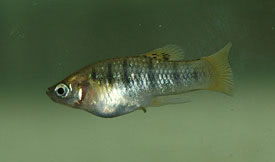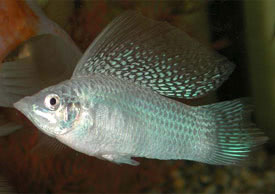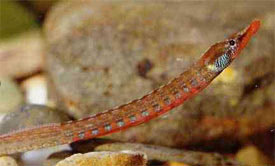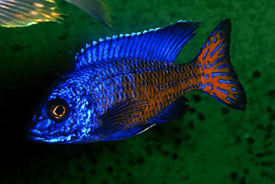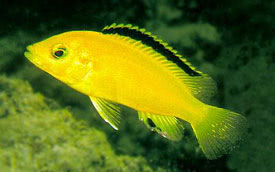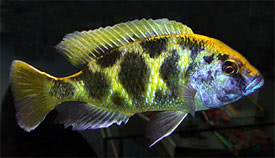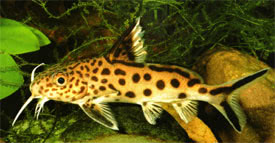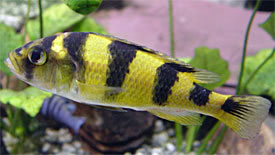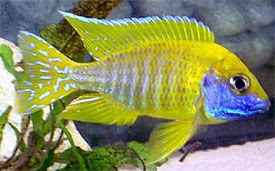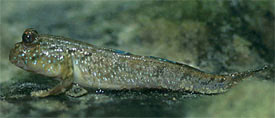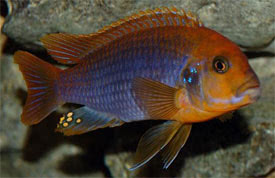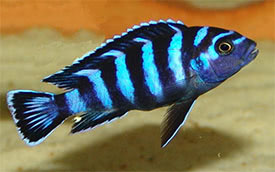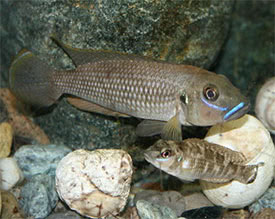
 Magyarul / Hungarian
Magyarul / Hungarian
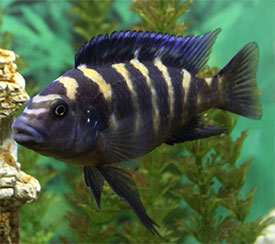


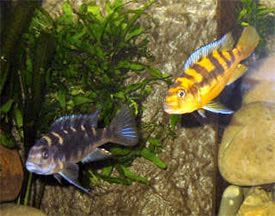
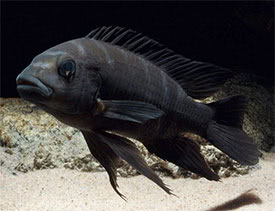
- Scientific name: Pseudotropheus crabro
- Synonyms: Melanochromis crabro (Ribbink & Lewis, 1982), Maylandia crabro (Ribbink & Lewis, 1982)
- Common name: Bumblebee Cichlid, Hornet Cichlid
- Group: Cichlids
- Habitat: Africa; Lake Malawi
- Size: 15-20 cm
- Biotope: Occurs in all kinds of habitats in the lake, but mostly found in large caves or near large boulders in 15-18 m depth.
- Social behavior: Aggressive and territorial mbuna that live in groups. Not a typical community fish, but it can be combined with other robust mbuna in a suitable sized aquarium. The dominant male can kill other males and even sometimes females.
- Diet: Omnivorous; In nature they eat all kinds of foods from fish eggs to small fish, but primarily they are cleaner fish specialized in feeding on parasites from larger fish like the catfish Bagrus meridionalis. In aquarium they eat all kinds of live, frozen and dired foods, but they also need some vegetable matter such as spirulina and spinach in their diet.
- Breeding: Quite easy
- Tank: Minimum 250 litres
- Population: 1 male and 6-7 females for 400 litres
- Decoration: Use a set-up with rock formations and provide many hiding places including caves, crevices, over-hangs, and tunnels. Use coral sand as substrate. The lighting can be strong to increase algae growth. Robust plants that can tolerate harder water can be used.
- Temperature: 24-29 °C
- pH: 7.5-8.8
- Hardness: 12-25 NK°
- Lifespan: 8-10 years
Description: Its scientific name were derived from the European Hornet (Vespa crabro), because both species are large sized and have a similar color patterning. Bumblebee Cichlid is an elongated cichlid with varoius colors, that depends on the sex, age, and geographical location of the fish. Males can be dark yellow or blue in color with eight or nine black, transverse bars. The first bar is found on the upper lip, and the next runs through the eye, while the last is on the base of the caudal fin. Some populations may also have horizontal stripes beside the transverse bars. Females are usually paler yellow with dark brown vertical bars. Both sexes have gray to black fins. These cichlids can change their color very rapidly from the attractive gold barred "bumble bee" look to almost jet black. They usually do this in the wild when they preying upon the eggs of the bagrus catfish, which also live and spawn in these caves. Pseudotropheus crabro specialized in feeding on parasites from these large catfishes which apparently recognises and tolerate them as a cleaner.
Mature males are a little larger, have darker colorations, and have 2-4 clearly pronounced egg spots, while females have rounded anal fin and only 1-2 egg spots. It is possible to breed them in aquarium: they are maternal mouthbrooders. It is best to purchase a group of juveniles and allow them to grow on together, but remember that the dominant male will kill any rivals, including subdominant males, so they should be removed with time. Breeding can be induced with a larger water change, when the male will darken to an almost jet black color. The dominant male will form a territory containing either a flat stone or a large rock, and tries to lure females to mate with him. When a female is ready to spawn, she swims into the spawning area, and lays the 20-60 eggs there, and quickly takes the eggs into her mouth. Then the male flares out his anal fin with the egg spots and the female tries to take them in her mouth as well. At this point the male releases the sperm and fertilize the eggs. The eggs are incubated in the female’s mouth for a period of 17 to 21 days before she releasing the free swimming fry. The male can harass the female during the incubation and she may spit out or eat the brood, so it is necessary to build many hiding places and caves where the female can hide. Another option is to place the female in a separate aquarium. Some experienced breeders strip the fry from the mother’s mouth after 18 days and raise them artificially, because females tend to over incubate the fry and they become too weak to eat when released. The fry grow very quickly, and the female will guard the young for a few days.







